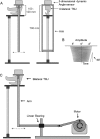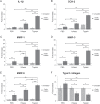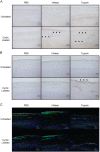Effects of enzymatic degradation after loading in temporomandibular joint
- PMID: 25503611
- PMCID: PMC4438732
- DOI: 10.1177/0022034514560588
Effects of enzymatic degradation after loading in temporomandibular joint
Abstract
Synovial fluid of the joint decreases friction between the cartilage surfaces and reduces cartilage wear during articulation. Characteristic changes of synovial fluid have been shown in patients with osteoarthritis (OA) in the temporomandibular joint (TMJ). OA is generally considered to be induced by excessive mechanical stress. However, whether the changes in synovial fluid precede the mechanical overloading or vice versa remains unclear. In the present study, our purpose was to examine if the breakdown of joint lubrication affects the frictional properties of mandibular condylar cartilage and leads to subsequent degenerative changes in TMJ. We measured the frictional coefficient in porcine TMJ by a pendulum device after digestion with hyaluronidase (HAase) or trypsin. Gene expressions of interleukin-1β (IL-1β), cyclooxygenase-2 (COX-2), matrix metalloproteinases (MMPs), type II collagen, and histology were examined after prolonged cyclic loading by an active pendulum system. The results showed that the frictional coefficient increased significantly after HAase (35%) or trypsin (74%) treatment. Gene expression of IL-1β, COX-2, and MMPs-1, -3, and -9 increased significantly in enzyme-treated TMJs after cyclic loading. The increase in the trypsin-treated group was greater than that in the HAase-treated group. Type II collagen expression was reduced in both enzyme-treated groups. Histology revealed surface fibrillation and increased MMP-1 in the trypsin-treated group, as well as increased IL-1β in both enzyme-treated groups after cyclic loading. The findings demonstrated that the compromised lubrication in TMJ is associated with altered frictional properties and surface wear of condylar cartilage, accompanied by release of pro-inflammatory and matrix degradation mediators under mechanical loading.
Keywords: cyclic loading; hyaluronan; lubrication; matrix metalloproteases; osteoarthritis; superficial zone protein.
© International & American Associations for Dental Research 2014.
Conflict of interest statement
The authors declare no potential conflicts of interest with respect to the authorship and/or publication of this article.
Figures




Similar articles
-
The effect of removal of the disc on the friction in the temporomandibular joint.J Oral Maxillofac Surg. 2006 Aug;64(8):1221-4. doi: 10.1016/j.joms.2006.04.017. J Oral Maxillofac Surg. 2006. PMID: 16860213
-
Interleukin-1 beta affects cyclooxygenase-2 expression and cartilage metabolism in mandibular condyle.Arch Oral Biol. 2011 Nov;56(11):1412-8. doi: 10.1016/j.archoralbio.2011.05.005. Epub 2011 Jun 16. Arch Oral Biol. 2011. PMID: 21683339
-
The frictional coefficient of the temporomandibular joint and its dependency on the magnitude and duration of joint loading.J Dent Res. 2004 May;83(5):404-7. doi: 10.1177/154405910408300510. J Dent Res. 2004. PMID: 15111633
-
Lubrication of the temporomandibular joint.Ann Biomed Eng. 2008 Jan;36(1):14-29. doi: 10.1007/s10439-007-9401-z. Epub 2007 Nov 6. Ann Biomed Eng. 2008. PMID: 17985243 Review.
-
Biomechanical and biochemical characteristics of the mandibular condylar cartilage.Osteoarthritis Cartilage. 2009 Nov;17(11):1408-15. doi: 10.1016/j.joca.2009.04.025. Epub 2009 May 18. Osteoarthritis Cartilage. 2009. PMID: 19477310 Review.
Cited by
-
Moderate mechanical stimulation rescues degenerative annulus fibrosus by suppressing caveolin-1 mediated pro-inflammatory signaling pathway.Int J Biol Sci. 2021 Apr 3;17(5):1395-1412. doi: 10.7150/ijbs.57774. eCollection 2021. Int J Biol Sci. 2021. PMID: 33867854 Free PMC article.
-
Diagnostic significance and evaluation of alterations in the superior joint space for temporomandibular joint fracture detection.Radiologie (Heidelb). 2025 Apr 25. doi: 10.1007/s00117-025-01446-w. Online ahead of print. Radiologie (Heidelb). 2025. PMID: 40281327 English.
-
A logistic analysis prediction model of TMJ condylar erosion in patients with TMJ arthralgia.BMC Oral Health. 2021 Jul 24;21(1):374. doi: 10.1186/s12903-021-01687-w. BMC Oral Health. 2021. PMID: 34303363 Free PMC article.
-
Temporomandibular joint degeneration arises spontaneously in STR/ort mice and is prevented by targeted aggrecanase inhibition.Osteoarthr Cartil Open. 2025 Mar 11;7(2):100599. doi: 10.1016/j.ocarto.2025.100599. eCollection 2025 Jun. Osteoarthr Cartil Open. 2025. PMID: 40207030 Free PMC article.
-
Inflammation-related collagen fibril destruction contributes to temporomandibular joint disc displacement via NF-κB activation.Int J Oral Sci. 2025 Apr 17;17(1):35. doi: 10.1038/s41368-025-00352-0. Int J Oral Sci. 2025. PMID: 40246831 Free PMC article.
References
-
- Alstergren P, Kopp S. 2000. Prostaglandin E2 in temporomandibular joint synovial fluid and its relation to pain and inflammatory disorders. J Oral Maxillofac Surg. 58(2):180–186. - PubMed
-
- Benz M, Chen N, Israelachvili J. 2004. Lubrication and wear properties of grafted polyelectrolytes, hyaluronan and hylan, measured in the surface forces apparatus. J Biomed Mater Res A. 71(1):6–15. - PubMed
-
- Chan SM, Neu CP, DuRaine G, Komvopoulos K, Reddi AH. 2010. Atomic force microscope investigation of the boundary-lubricant layer in articular cartilage. Osteoarthritis Cartilage. 18(7):956–963. - PubMed
-
- Chan SM, Neu CP, Komvopoulos K, Reddi AH. 2011. Dependence of nanoscale friction and adhesion properties of articular cartilage on contact load. J Biomech. 44(7):1340–1345. - PubMed
Publication types
MeSH terms
Substances
LinkOut - more resources
Full Text Sources
Other Literature Sources
Research Materials

